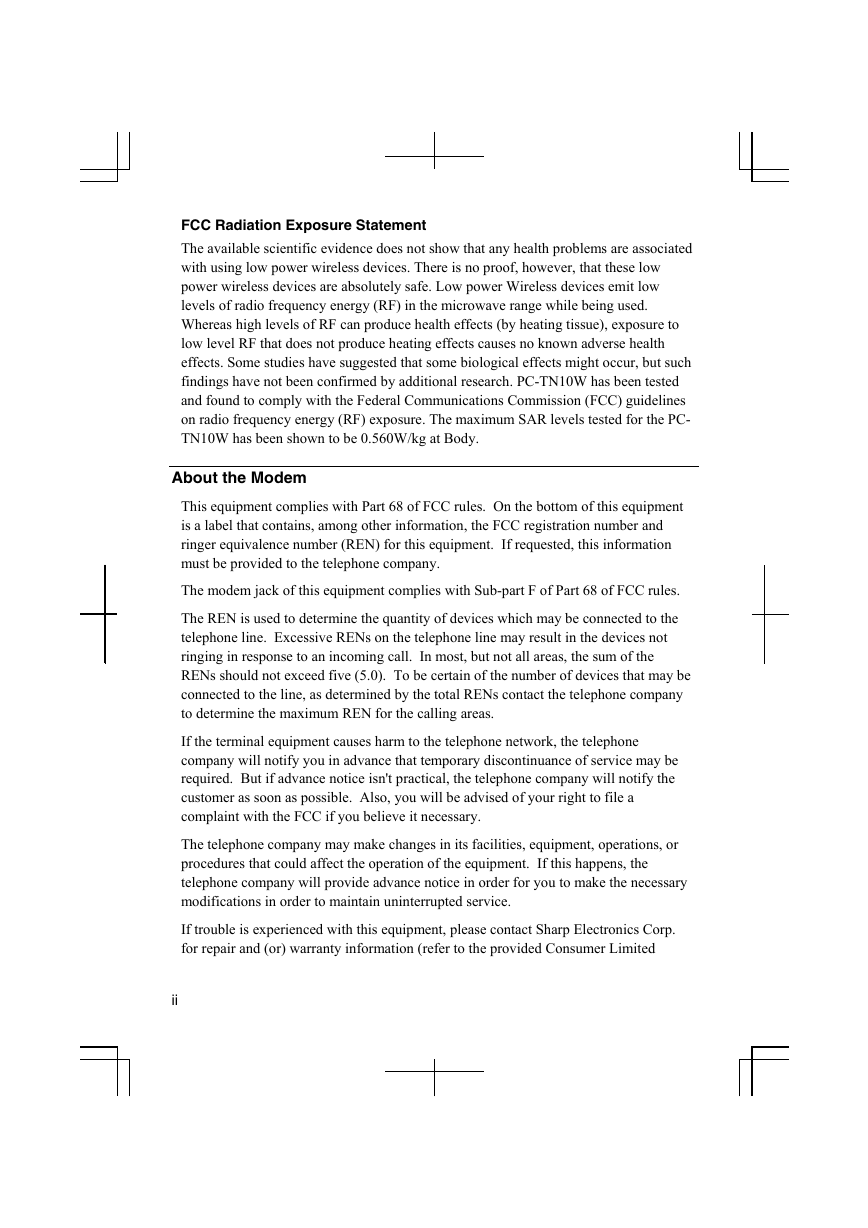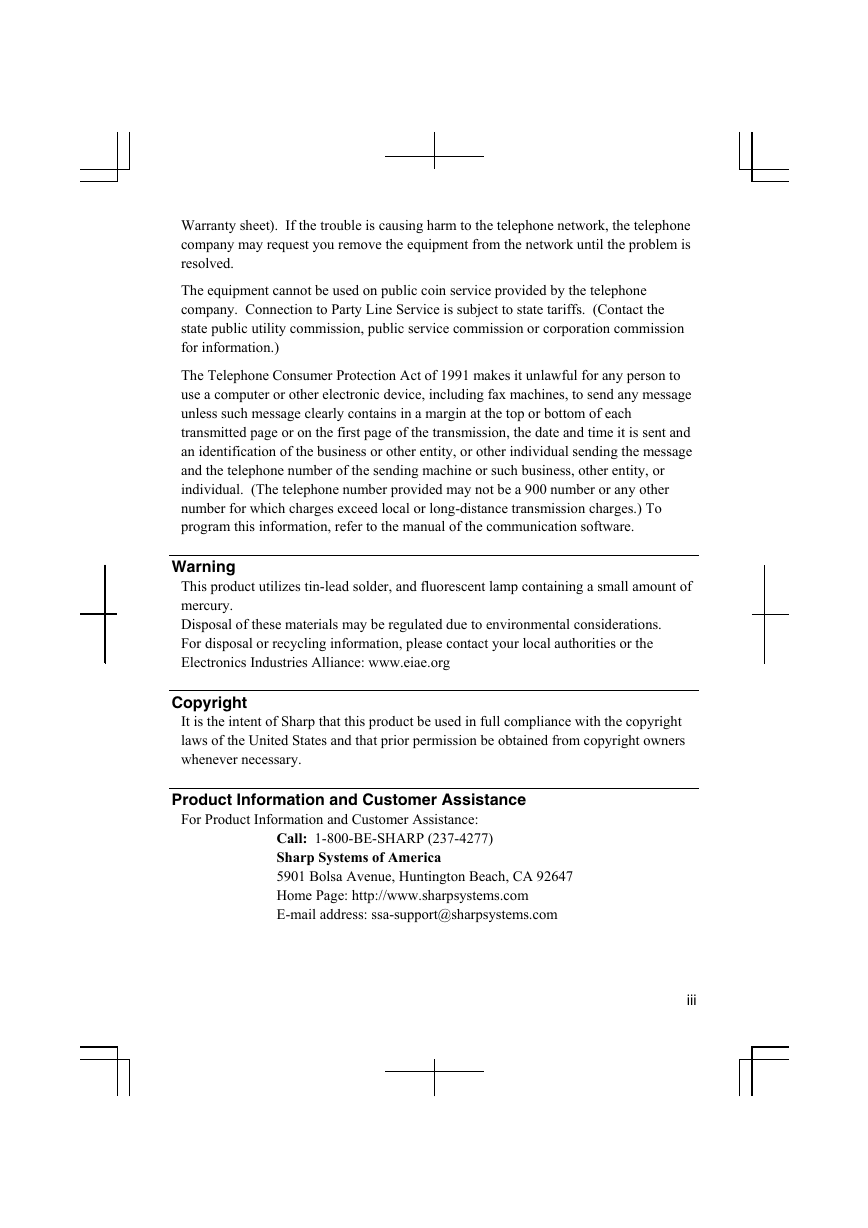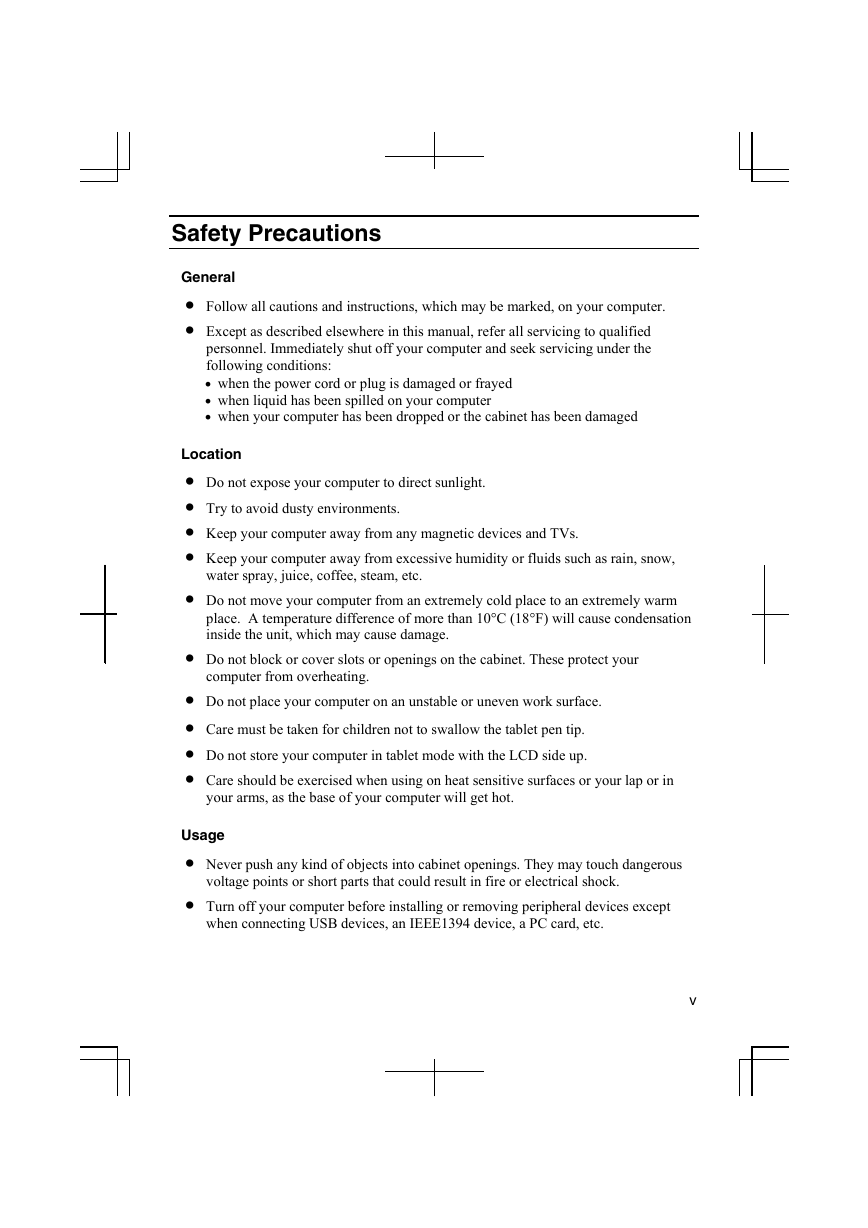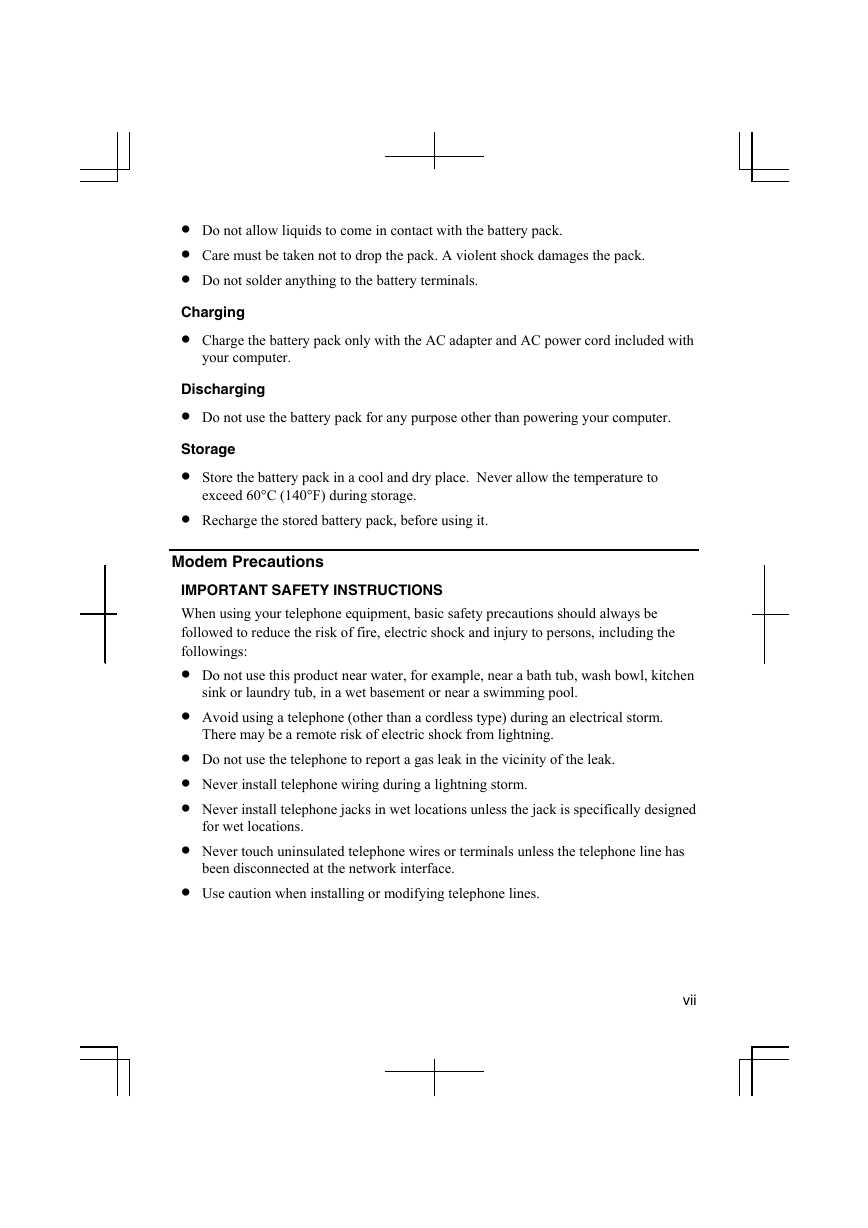���'N�2=CA�� �"�2 �$�!���
,1+�!JD $"�
,1+ #& *�=?�
+�����$��;����
+�����;��2����
2
+
�
6
�
�
5
A
H
E
A
I
1
�
2
-
4
)
6
�
�
�
)
�
7
)
�
��6-*��� +��276-4
2+�6�� 5AHEAI
�2-4)61�� �)�7)�
50)42 +�42�4)61��
��! 50)42 +�42�4)61��
241�6-, 1� �)2)�
61�5-!#'�)+��
�
Notice for Users in the USA
FCC Statement
WARNING - FCC Regulations state that any unauthorized changes or modifications to
this equipment not expressly approved by the manufacturer could void the user’s
authority to operate this equipment.
Note: This equipment has been tested and found to comply with the limits for a
Class B digital device pursuant to Part 15 of the FCC Rules.
These limits are designed to provide reasonable protection against harmful interference in a
residential installation. This equipment generates, uses and can radiate radio frequency
energy and, if not installed and used in accordance with the instructions, may cause harmful
interference to radio communications. However, there is no guarantee that interference will
not occur in a particular installation. If this equipment does cause harmful interference to
radio or television reception, which can be determined by turning the equipments off and
on, the user is encouraged to try to correct the interference by one or more of the following
measures:
• Reorient or relocate the receiving antenna.
• Increase the distance between the equipment and receiver.
• Connect the equipment into an outlet on a circuit different from that to which the
• Consult the dealer or an experienced radio/TV technician for help.
A shielded I/F cable is required to insure compliance with FCC regulation for Class B
computing equipment.
* As an ENERGY STAR® Partner, SHARP has determined that this product meets
receiver is connected.
the ENERGY STAR® guidelines for energy efficiency.
Declaration of Conformity
SHARP PERSONAL COMPUTER, PC-TN Series.
This device complies with part 15 of the FCC rules. Operation is subject to the following
conditions:(1) this device may not cause harmful interference, and (2) this device must accept
any interference received, including interference that may cause undesired operation.
Responsible Party: SHARP ELECTRONICS CORPORATION
Sharp Plaza, Mahwah, New Jersey 07430-2135
TEL: 1-800-BE-SHARP
i
�
FCC Radiation Exposure Statement
The available scientific evidence does not show that any health problems are associated
with using low power wireless devices. There is no proof, however, that these low
power wireless devices are absolutely safe. Low power Wireless devices emit low
levels of radio frequency energy (RF) in the microwave range while being used.
Whereas high levels of RF can produce health effects (by heating tissue), exposure to
low level RF that does not produce heating effects causes no known adverse health
effects. Some studies have suggested that some biological effects might occur, but such
findings have not been confirmed by additional research. PC-TN10W has been tested
and found to comply with the Federal Communications Commission (FCC) guidelines
on radio frequency energy (RF) exposure. The maximum SAR levels tested for the PC-
TN10W has been shown to be 0.560W/kg at Body.
About the Modem
This equipment complies with Part 68 of FCC rules. On the bottom of this equipment
is a label that contains, among other information, the FCC registration number and
ringer equivalence number (REN) for this equipment. If requested, this information
must be provided to the telephone company.
The modem jack of this equipment complies with Sub-part F of Part 68 of FCC rules.
The REN is used to determine the quantity of devices which may be connected to the
telephone line. Excessive RENs on the telephone line may result in the devices not
ringing in response to an incoming call. In most, but not all areas, the sum of the
RENs should not exceed five (5.0). To be certain of the number of devices that may be
connected to the line, as determined by the total RENs contact the telephone company
to determine the maximum REN for the calling areas.
If the terminal equipment causes harm to the telephone network, the telephone
company will notify you in advance that temporary discontinuance of service may be
required. But if advance notice isn't practical, the telephone company will notify the
customer as soon as possible. Also, you will be advised of your right to file a
complaint with the FCC if you believe it necessary.
The telephone company may make changes in its facilities, equipment, operations, or
procedures that could affect the operation of the equipment. If this happens, the
telephone company will provide advance notice in order for you to make the necessary
modifications in order to maintain uninterrupted service.
If trouble is experienced with this equipment, please contact Sharp Electronics Corp.
for repair and (or) warranty information (refer to the provided Consumer Limited
ii
�
Warranty sheet). If the trouble is causing harm to the telephone network, the telephone
company may request you remove the equipment from the network until the problem is
resolved.
The equipment cannot be used on public coin service provided by the telephone
company. Connection to Party Line Service is subject to state tariffs. (Contact the
state public utility commission, public service commission or corporation commission
for information.)
The Telephone Consumer Protection Act of 1991 makes it unlawful for any person to
use a computer or other electronic device, including fax machines, to send any message
unless such message clearly contains in a margin at the top or bottom of each
transmitted page or on the first page of the transmission, the date and time it is sent and
an identification of the business or other entity, or other individual sending the message
and the telephone number of the sending machine or such business, other entity, or
individual. (The telephone number provided may not be a 900 number or any other
number for which charges exceed local or long-distance transmission charges.) To
program this information, refer to the manual of the communication software.
Warning
This product utilizes tin-lead solder, and fluorescent lamp containing a small amount of
mercury.
Disposal of these materials may be regulated due to environmental considerations.
For disposal or recycling information, please contact your local authorities or the
Electronics Industries Alliance: www.eiae.org
Copyright
It is the intent of Sharp that this product be used in full compliance with the copyright
laws of the United States and that prior permission be obtained from copyright owners
whenever necessary.
Product Information and Customer Assistance
For Product Information and Customer Assistance:
Call: 1-800-BE-SHARP (237-4277)
Sharp Systems of America
5901 Bolsa Avenue, Huntington Beach, CA 92647
Home Page: http://www.sharpsystems.com
E-mail address: ssa-support@sharpsystems.com
iii
�
CAUTION:
TO PREVENT ELECTRICAL SHOCK, DISCONNECT THE AC CORD AND THE
BATTERY BEFORE SERVICING.
CAUTION:
FOR A COMPLETE ELECTRICAL DISCONNECTION, PULL OUT THE MAINS
PLUG AND THE BATTERY.
VORSICHT:
UM DIE STROMZUFUHR VOLLSTÄNDIG ZU UNTERBRECHEN, DEN
NETZSTECKER HERAUSZIEHEN UND DIE BATTERIE ÈNTFERNEN.
ATTENTION:
POUR UN ARRET TOTAL DU SYSTEME, DECONNECTEZ LA PRISE DE
COURANT SECTEUR ET LA BATTERIE.
VARNING:
FÖR TOTAL ELEKTRISK URKOPPLING, KOPPLA UR KONTAKTEN OCH TA
UR BATTERIET.
PRECAUCION:
PARA UNA COMPLETA DESCONEXION ELECTRICA DESENCHUFE LA
CLAVIJA DE LA RED Y LA BATERIA.
iv
�
Safety Precautions
General
• Follow all cautions and instructions, which may be marked, on your computer.
• Except as described elsewhere in this manual, refer all servicing to qualified
personnel. Immediately shut off your computer and seek servicing under the
following conditions:
• when the power cord or plug is damaged or frayed
• when liquid has been spilled on your computer
• when your computer has been dropped or the cabinet has been damaged
Location
• Do not expose your computer to direct sunlight.
• Try to avoid dusty environments.
• Keep your computer away from any magnetic devices and TVs.
• Keep your computer away from excessive humidity or fluids such as rain, snow,
• Do not move your computer from an extremely cold place to an extremely warm
place. A temperature difference of more than 10°C (18°F) will cause condensation
inside the unit, which may cause damage.
water spray, juice, coffee, steam, etc.
computer from overheating.
• Do not block or cover slots or openings on the cabinet. These protect your
• Do not place your computer on an unstable or uneven work surface.
• Care must be taken for children not to swallow the tablet pen tip.
• Do not store your computer in tablet mode with the LCD side up.
• Care should be exercised when using on heat sensitive surfaces or your lap or in
your arms, as the base of your computer will get hot.
Usage
• Never push any kind of objects into cabinet openings. They may touch dangerous
• Turn off your computer before installing or removing peripheral devices except
voltage points or short parts that could result in fire or electrical shock.
when connecting USB devices, an IEEE1394 device, a PC card, etc.
v
�
the power cord immediately if damage is found.
• Check the AC power cord and power connectors periodically for damage. Change
• Be careful not to get burned by the heated air from the ventilation openings when
using your computer on your lap or in your arms for extended period. If you feel
uncomfortable, stop using it until it becomes cool.
computer for extended period.
• Do not exposure any part of your body to the palm rest or the bottom of your
• Never subject your computer to sudden shocks or extreme vibration.
• Do not drop your computer nor hit it with other equipment.
• Do not scratch the surface of the LCD screen.
• Turn off your computer and disconnect the AC power cord before cleaning.
Battery Precautions
CAUTION
DANGER OF EXPLOSION IF BATTERY IS INCORRECTLY REPLACED.
REPLACE ONLY WITH THE SAME OR EQUIVALENT TYPE RECOMMENDED
BY THE MANUFACTURER. DISCARD USED BATTERIES ACCORDING TO
THE MANUFACTURER'S INSTRUCTIONS.
Handling
• Never put the battery pack in a fire, as it could explode and cause injury.
• Do not attempt to open or alter the battery pack.
• Do not place the battery where it might get hotter than 60°C (140°F).
• The battery pack must be kept from metal objects such as jewelry and liquids. They
might trigger a short circuit and consequently cause the battery pack to heat up and
explode.
vi
�
• Do not allow liquids to come in contact with the battery pack.
• Care must be taken not to drop the pack. A violent shock damages the pack.
• Do not solder anything to the battery terminals.
Charging
• Charge the battery pack only with the AC adapter and AC power cord included with
your computer.
Discharging
• Do not use the battery pack for any purpose other than powering your computer.
Storage
• Store the battery pack in a cool and dry place. Never allow the temperature to
• Recharge the stored battery pack, before using it.
Modem Precautions
exceed 60°C (140°F) during storage.
There may be a remote risk of electric shock from lightning.
sink or laundry tub, in a wet basement or near a swimming pool.
IMPORTANT SAFETY INSTRUCTIONS
When using your telephone equipment, basic safety precautions should always be
followed to reduce the risk of fire, electric shock and injury to persons, including the
followings:
• Do not use this product near water, for example, near a bath tub, wash bowl, kitchen
• Avoid using a telephone (other than a cordless type) during an electrical storm.
• Do not use the telephone to report a gas leak in the vicinity of the leak.
• Never install telephone wiring during a lightning storm.
• Never install telephone jacks in wet locations unless the jack is specifically designed
• Never touch uninsulated telephone wires or terminals unless the telephone line has
• Use caution when installing or modifying telephone lines.
for wet locations.
been disconnected at the network interface.
vii
�
















 2023年江西萍乡中考道德与法治真题及答案.doc
2023年江西萍乡中考道德与法治真题及答案.doc 2012年重庆南川中考生物真题及答案.doc
2012年重庆南川中考生物真题及答案.doc 2013年江西师范大学地理学综合及文艺理论基础考研真题.doc
2013年江西师范大学地理学综合及文艺理论基础考研真题.doc 2020年四川甘孜小升初语文真题及答案I卷.doc
2020年四川甘孜小升初语文真题及答案I卷.doc 2020年注册岩土工程师专业基础考试真题及答案.doc
2020年注册岩土工程师专业基础考试真题及答案.doc 2023-2024学年福建省厦门市九年级上学期数学月考试题及答案.doc
2023-2024学年福建省厦门市九年级上学期数学月考试题及答案.doc 2021-2022学年辽宁省沈阳市大东区九年级上学期语文期末试题及答案.doc
2021-2022学年辽宁省沈阳市大东区九年级上学期语文期末试题及答案.doc 2022-2023学年北京东城区初三第一学期物理期末试卷及答案.doc
2022-2023学年北京东城区初三第一学期物理期末试卷及答案.doc 2018上半年江西教师资格初中地理学科知识与教学能力真题及答案.doc
2018上半年江西教师资格初中地理学科知识与教学能力真题及答案.doc 2012年河北国家公务员申论考试真题及答案-省级.doc
2012年河北国家公务员申论考试真题及答案-省级.doc 2020-2021学年江苏省扬州市江都区邵樊片九年级上学期数学第一次质量检测试题及答案.doc
2020-2021学年江苏省扬州市江都区邵樊片九年级上学期数学第一次质量检测试题及答案.doc 2022下半年黑龙江教师资格证中学综合素质真题及答案.doc
2022下半年黑龙江教师资格证中学综合素质真题及答案.doc